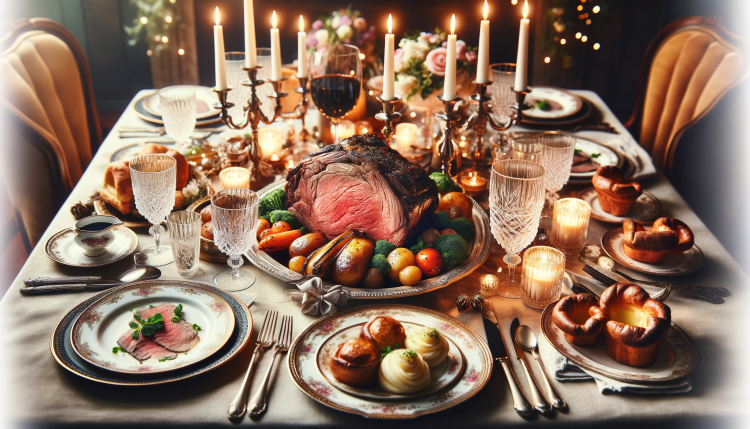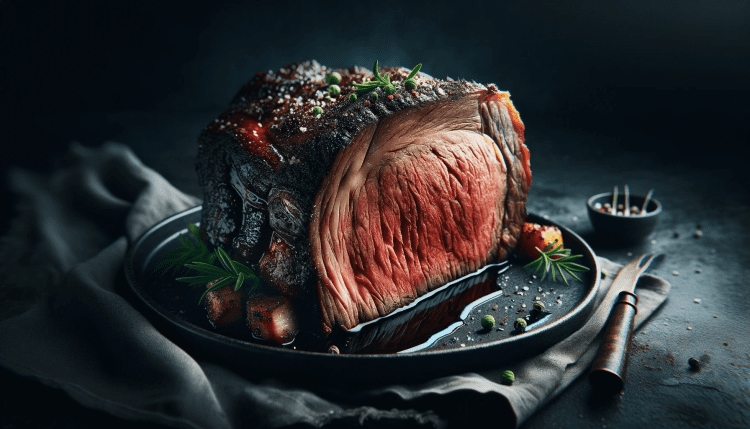
The Ultimate Guide to Making the Perfect Prime Rib
When it comes to a show-stopping centerpiece for a special dinner or holiday feast, few dishes can rival the grandeur and flavor of a perfectly cooked prime rib. Also known as a standing rib roast, this cut of beef is celebrated for its rich marbling, tender texture, and succulent taste. But despite its reputation as a gourmet dish, making a prime rib at home is less daunting than you might think. In this comprehensive guide, we’ll walk you through every step of preparing and cooking a prime rib, ensuring that even first-timers can achieve a restaurant-quality result.
Understanding Prime Rib
Before diving into the cooking process, it’s essential to understand what prime rib is. Prime rib comes from the rib section of the cow and is known for its generous marbling, which contributes to its tenderness and flavor. It’s typically sold in various sizes, often denoted by the number of ribs. A full prime rib (which includes seven ribs) can feed a large group, making it an ideal choice for gatherings.
Selecting Your Prime Rib
The journey to a perfect prime rib begins at the butcher’s counter. Here are some tips for selecting your roast:
- Grade Matters: Look for USDA Prime or Choice cuts. Prime has more marbling, but Choice is also excellent.
- Bone-In or Boneless?: A bone-in roast is traditional and adds flavor and moisture, but a boneless roast is easier to carve. It’s a matter of personal preference.
- Size It Right: Generally, plan for one rib for every two people. If you’re serving a crowd, a three or four-rib roast is a good size.
Preparing the Prime Rib
Now that you’ve selected your prime rib, let’s prepare it for the oven.
- Temperature is Key: Remove your prime rib from the refrigerator at least 2 to 3 hours before cooking. Allowing the meat to come to room temperature ensures even cooking.
- Seasoning Your Roast: Pat the roast dry with paper towels and generously season it. Use kosher salt and freshly ground black pepper for a classic flavor. For a more aromatic crust, consider adding herbs like rosemary or thyme and minced garlic.
- To Sear or Not to Sear?: Some chefs recommend searing the roast in a hot skillet before roasting, claiming it locks in juices. However, others argue that roasting at high heat initially, followed by a lower temperature, achieves the same effect. We’ll follow the latter method for simplicity and equally delicious results.
Cooking the Prime Rib
Cooking a prime rib to perfection is all about temperature control and timing.
- Preheat Your Oven: Preheat your oven to a roaring 450°F (230°C). This high heat will start the cooking process and help form a delicious crust on the outside of the roast.
- Roasting: Place your seasoned roast in a heavy, oven-safe roasting pan, bone-side down. The bones create a natural rack, allowing the heat to circulate evenly. Roast at 450°F for 20 minutes, then reduce the oven to 325°F. Continue roasting, estimating about 15 minutes per pound for a medium-rare finish.
- Monitoring Temperature: The most reliable way to ensure your prime rib is cooked to your liking is to use a meat thermometer. For medium-rare, you’re aiming for an internal temperature of 120°F to 130°F. Remember, the roast will continue to cook as it rests, raising the temperature another 5°F to 10°F.
- Resting the Roast: This step is critical. Once your roast reaches the desired temperature, remove it from the oven and let it rest for at least 20 minutes. This pause allows the juices to redistribute, resulting in a juicier, more flavorful prime rib.


Carving and Serving
With your prime rib cooked and rested, it’s time for the grand reveal. Carving a prime rib can be as simple or as ceremonial as you like. Place the roast on a large cutting board, and if it’s bone-in, you might want to remove the bones first for easier slicing. Use a sharp carving knife and slice against the grain to your desired thickness. Serve the slices with side dishes that complement the rich flavor of the beef, such as roasted vegetables, creamy mashed potatoes, or a crisp salad.
Side Dishes to Complement Your Prime Rib
A well-chosen side dish can elevate your prime rib from a mere meal to a memorable feast. Here are some classic accompaniments:
- Yorkshire Pudding: This traditional British side dish is a perfect match for prime rib. Made from a simple batter of eggs, flour, and milk, Yorkshire pudding puffs up in the oven and is ideal for soaking up the meat’s juices.
- Roasted Vegetables: Vegetables like carrots, Brussels sprouts, and parsnips roasted in the oven alongside the meat, absorb the flavors and become deliciously caramelized.
- Mashed Potatoes: Creamy and buttery, mashed potatoes are a classic pairing for prime rib. Add some garlic or cheese for an extra flavor twist.
- Green Beans Almondine: For a lighter side, green beans tossed with almonds and a hint of lemon juice offer a crisp, flavorful contrast to the rich beef.
- Horseradish Sauce: The sharp, tangy flavor of horseradish sauce cuts through the richness of the meat, providing a refreshing balance.
Making the Most of Leftovers
If you find yourself with leftover prime rib, rejoice! There are many delicious ways to repurpose it:
- Prime Rib Sandwiches: Thinly slice the leftover prime rib and pile it on a crusty baguette with horseradish cream, arugula, and caramelized onions for a gourmet sandwich.
- Beef Stroganoff: Cut the meat into chunks and simmer it in a creamy mushroom sauce, then serve over noodles or rice for a comforting next-day meal.
- Beef and Vegetable Soup: Cube the prime rib and add it to a hearty soup with vegetables and broth for a warming winter dish.
Wine Pairing
No luxurious dinner is complete without the perfect wine. Prime rib, with its rich flavors, pairs beautifully with full-bodied red wines:
- Cabernet Sauvignon: This classic pairing stands up to the richness of the meat with its full body and tannic structure.
- Merlot: For those who prefer a softer, fruitier red, Merlot is an excellent choice.
- Syrah/Shiraz: These wines offer bold flavors that complement the savory beef without overpowering it.
The Final Touch: Presentation
Presentation is key to turning your meal into an experience. Consider these tips:
- Carve at the Table: If you’re comfortable, carve the prime rib at the table. It adds a sense of ceremony to your meal and allows guests to request their preferred doneness.
- Garnish Thoughtfully: Simple garnishes like a sprig of rosemary or thyme can elevate the look of your dish.
- Serve on Warm Plates: Warm your plates in the oven before serving. This small touch keeps the meat warm as your guests savor their meal.
Remember, cooking is not just about following a recipe—it’s about the experience and the joy of sharing a delicious meal with loved ones. So, gather your ingredients, preheat your oven, and embark on the journey of making the perfect prime rib. Bon appétit!


The Perfect Prime Rib Recipe
Ingredients
- 1 prime rib roast (size depends on the number of servings you need; typically, one rib feeds two people)
- Kosher salt
- Freshly ground black pepper
- Optional: fresh herbs like rosemary or thyme, garlic
Instructions
- Bring the Roast to Room Temperature: Remove the prime rib from the refrigerator and let it sit at room temperature for about 2 to 3 hours before cooking. This step is crucial for even cooking.
- Preheat Your Oven: Preheat the oven to 450°F (230°C). This high initial temperature will help create a nice crust.
- Season the Roast: Pat the roast dry with paper towels. Generously season all sides of the roast with kosher salt and freshly ground black pepper. If you’re using herbs and garlic, rub them over the meat.
- Prepare for Roasting: Place the roast bone-side down in a roasting pan. If you don’t have a bone-in roast, place the meat on a rack in the pan. The bones act as a natural rack, allowing heat to circulate around the meat.
- Roast at High Temperature: Place the roast in the preheated oven and cook at 450°F (230°C) for about 20 minutes.
- Lower the Oven Temperature: After 20 minutes, reduce the oven temperature to 325°F (165°C) and continue roasting. The general rule of thumb is to cook the roast for about 15 minutes per pound for medium-rare, but it’s always best to use a meat thermometer. Aim for an internal temperature of 120°F to 130°F (49°C to 54°C) for medium-rare.
- Rest the Meat: Once your roast reaches the desired internal temperature, remove it from the oven and let it rest on a cutting board for at least 20 minutes before carving. This allows the juices to redistribute throughout the meat, ensuring a juicy prime rib.
- Carve and Serve: Carve the roast by slicing against the grain. Serve with your choice of sides, like roasted vegetables, mashed potatoes, or a simple salad.
Tips
- Size Matters: The cooking time will vary depending on the size of your roast, so it’s essential to use a meat thermometer.
- Herb and Garlic Rub: Enhance the flavor with a rub made from minced garlic, chopped fresh herbs, olive oil, salt, and pepper.
- Au Jus: For a simple au jus, deglaze the roasting pan with some beef broth and red wine, scraping up the tasty bits from the bottom of the pan.
Enjoy your meal! Remember, the key to a perfect prime rib is in the temperature control and allowing the meat to rest before carving.





